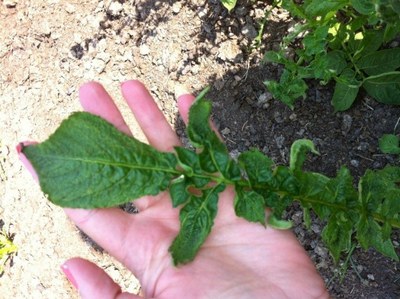Is My Compost “Contaminated”?
Herbicides are a common and widely accepted tool used to control weeds or undesirable vegetation. Persistent herbicides are long-acting herbicides used on hard-to-control weeds, often broadleaves. This type of herbicide may be used on grain crops, lawns, pastures and hayfields to successfully control weeds, year after year.
While persistent products are praised by many because of their effectiveness, they are also cursed by many…because of their effectiveness. Typically those cursing don’t know they are dealing with a persistent herbicide until damage to desirable plants occurs. When we paint a fence we can see the paint persists for many years; however when we spray weeds we do not see the herbicide persist in the soil or on the plant vegetation.
These products only become an issue when either crop rotation restrictions are not followed (field scale) or you use “contaminated” compost in your vegetable plots, garden, high tunnel, etc.
So how do persistent herbicides end up in compost? If you follow the graphic provided on the label of Milestone® (https://s3-us-west-2.amazonaws.com/greenbook-assets/L79495.pdf) you will see that when the herbicide is applied to either a hayfield or pasture and consumed by an animal it simply passes through the animal (no harm done to the animal) and remains effective (no harm done to the herbicide) in the manure. If this “herbicide-contaminated” manure is applied to any broadleaf crop damage may occur. Composting the manure does not lessen the persistence of every herbicide either. So when “contaminated” compost is applied to vegetable plots, gardens, etc. the outcome for sensitive crops (beans, tomatoes, potatoes, peppers) is stunted growth and decreased yields, and possibly death. Keep in mind that manure from herbicide-treated crops can be managed by following herbicide-specific label instructions.

Example of plant damage resulting from application of manure containing a persistent herbicide. Photo from NDSU Sheridan Co. Extension office.
How do you know if your field is ready to plant? You should always follow label instructions and rotation restrictions. You may also follow the Field Bioassay Instructions found on page 101 of the 2017 ND Weed Control Guide. For some herbicides, dilution of the product in the soil by way of tillage is another method to reduce the risk of carryover (page 100-101).
How do you know if your compost is herbicide free and ready to use? You can conduct a simple plant bioassay by following these steps from Washington State University: https://puyallup.wsu.edu/soils/wp-content/uploads/sites/411/2014/12/PDF_Clopyralid_Bioassay.pdf. Dow AgroSciences offers a testing protocol as well: http://www.manurematters.com/na/en/bioassay.htm. If you find that you have residue issues you can possibly use dilution as a means of mitigation here too, depending on the concentration of residual.
Whether you’re working with persistent herbicides on a field-scale or in your garden, it’s important to follow label instructions, rotation restrictions and inform those who may purchase hay, manure or compost from you about what you have used. Great stewardship will keep all of our plants growing!
Mary Berg
Area Extension Specialist
Livestock Environmental Management


